Your Indoor-only Cat Got Out the Door!
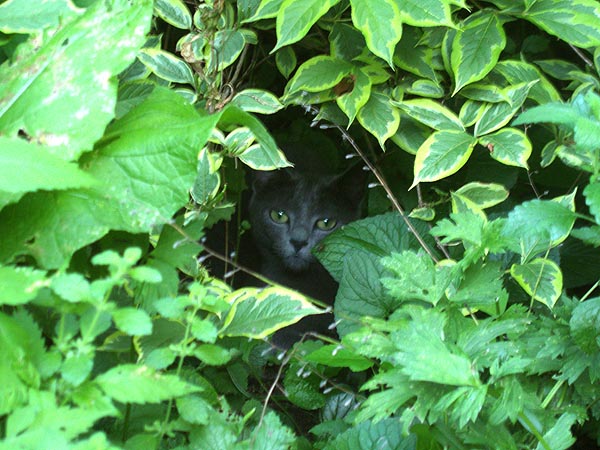
You may see your cat escape or you may realize you haven’t seen your cat around the house in a while, but suddenly you are panicked that your beloved kitty may have escaped the house and you can’t focus on what to do first or next or after that to bring kitty back home safely. This article covers methods for finding an indoor-only cat who has escaped your home, but also has information on lost or displaced cat behavior in general.
Lost cat behavior
93% of escaped indoor-only cats were found hiding within a 3-house radius of their escape point.
While you may want to race outside running up and down the streets calling for your cat, that is rarely helpful. Often the first suggestions are to call local shelters or go there to check the cages, put up signs and share the loss on social media. Broadcasting that your cat is lost lets people know and you do need to do that, but most cats don’t run the streets when first lost, so unless someone knows where to look they aren’t likely to see your cat. You may do these things, but you can leave those activities for a little later. Your greatest advantage is actually looking for your cat during the first hours when your cat has disappeared.
Success in finding your cat and bringing it safely back home depends on narrowing down your search by determining:
- if your cat did escape, and if so, how your cat escaped
- your own knowledge of your cat’s personality
- an understanding of how cats react to finding themselves outside of their territory
- how long they may have been gone
Search inside your house
If you can’t find your cat and also can’t find a convincing exit point, your cat may still be in your home somewhere.
It’s very important to also use a good flashlight that you can shine into every nook and cranny. Even if you have excellent eyesight and daylight, cats can fit inside darned small places that are usually dark, and if a cat is holding completely still whether asleep or frightened you’d be surprised that you’d overlook it. The flashlight will help highlight details and most importantly will shine on their eyes in dark spaces. Look inside of every closed door and cabinet and inside every trash can and other container, in the rafters in your basement, in areas your cat may have gained access to such as the attic or crawl spaces, in the underside of mattresses and furniture, between the clothes in your closet, the possibilities are endless but take at least a half hour if not more to search the inside of your home.
Cats, territory and behavior, before you begin your search
Their territory is their safe space because they have determined predators can’t get to them, food and water are available, the natives are friendly, and they work every day to keep it that way.
Think of your cat at the veterinarian’s office, a new cat when you bring it into your home, or even cats in a shelter. This is why people are often puzzled when they search for their cat and actually see it and it won’t come to them, or it isn’t friendly with people as it usually is. The cat has lost its safe space where it knows the sounds and smells and the expected activities and feels exposed and in danger. A cat’s survival instinct tells it to get into a place where it is protected on all sides from predators, to keep still and quiet until it becomes familiar with the new space, then begin to explore and adapt to the new reality a little at a time. How cats do this, and how quickly, depends on your cat’s personality, and is part of what will guide your search.
Plan your outdoor search
You need to take many actions but can’t do them all at once, so using points one through four above, determining if they escaped, how and when they escaped and considering characteristics of their personality, will help you focus on a likely area to search and begin with the best methods for success.
Indoor-only cats who’ve escaped outside their territory inside the house rarely go far at the time they escape.
At this point, you are not looking for a cat on the run, but a cat in hiding, so don’t go on a chase, look for clues.
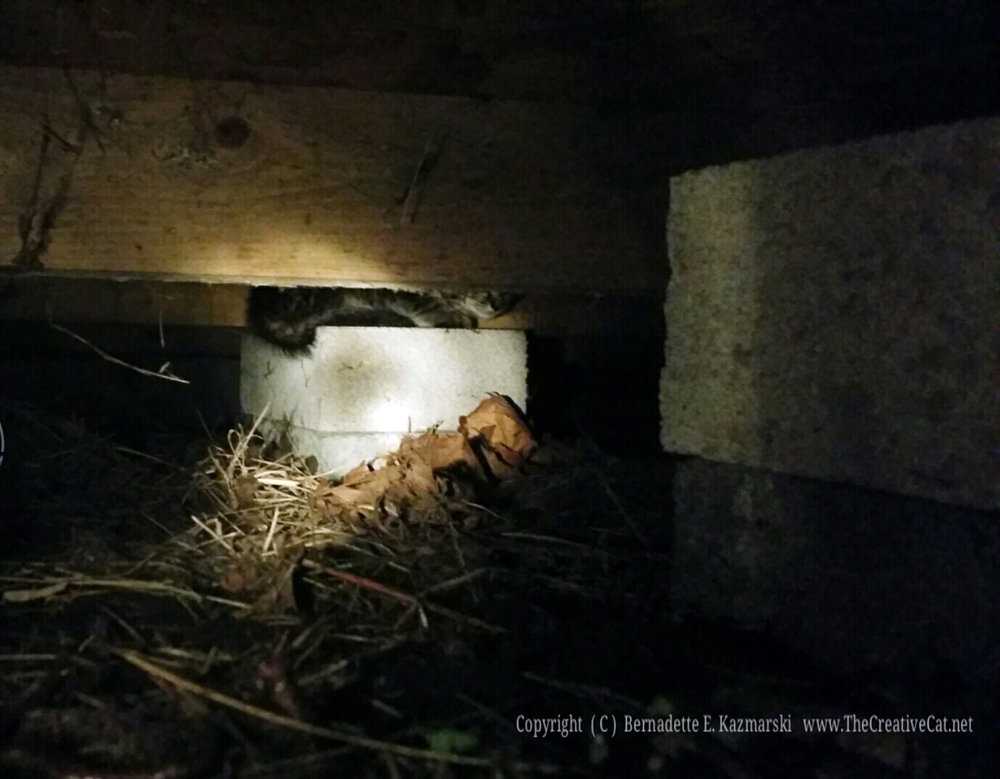
Determining how your cat escaped and beginning your search
Here is a quick outline, with details below:
- Find the likely exit point for your cat, a door or window or other opening. If you can, leave that point open, confine other cats and make it accessible to the lost cat. Many cats end up returning to the point they left from and re-enter the home on their own.
- Search around your home and yard using a flashlight and possibly softly shaking a bag of treats and softly calling your cat’s name, thoroughly look into every confined space on and around your house and in foliage.
- Visit neighbors on each side, explain your situation, ask to search their yards as well, giving them a photo of your cat in case they see it in their yard.
- Contact local shelters, police and any other authorities that might collect your cat.
- Make Lost Cat flyers and post them all over your street and also on the streets around yours, focusing on the corners of intersections, and give them to your neighbors.
- Borrow or purchase a humane trap, learn how to use it, and set it up baited with food in a likely place for your cat, stay near and watch it.
- Choose a place each day to thoroughly search again where your cat might be hiding.
- Visit your local shelters in person at least every other day to see the cats who’ve come in as strays.
Because indoor-only cats quickly look for a safe place to hide when they find themselves outside of their own territory, finding how and where your cat escaped will help direct you to a likely area outside where your cat might be hiding. Did you find a loose window screen, an open door, did someone visit who may not have noticed your cat run out the door when they came in, or did your cat run past you when you entered or left?
Most of the time when cats run out a door or open window they quickly realize they are outside of their territory…Their next move is to find the closest safe place to hide.
Focus first on these areas. Plan a search beginning on the side of the house where you believe they escaped and carefully fan out from that spot to investigate all possible hiding places. Calling them loudly or shaking the treats at this point may startle them, so call softly while quietly moving and shining your flashlight, even in daylight, inside and behind shrubs, underneath structures and vehicles, even going back multiple times from different angles to search the same places.
Talk to your neighbors, give them a photo of your cat and ask for permission to search their yards in the same way, then proceed.
Several years ago a friend called to tell me her cat Buster** had gotten out the door when someone visited, most likely the back door. They had just moved back to the area to a condo so the neighborhood was even new to her. She looked for days, in the house, outside, front, back. One night four or five days later she sat on the back porch slouched against the wall and just for the heck of it she shone her flashlight out into the darkness—and saw two glowing eyes in the tiny crawlspace under the shed, directly across the yard from the door. He apparently had run out the open door and kept going in the darkness that night, finding shelter in the space under the shed and not moved at all. He was in a “frozen feline” state where they don’t react to their surroundings so she had to pull him out, but he was back.
Flyers, notices and calls
Flyers may seem old-fashioned but they put your cat right in front of the people most likely to see your cat if it’s hiding on their property or starts to move around.
Visit shelters every other day to make sure you see all the new cats brought in. Many shelters do not have stray holds for cats.
Borrow or purchase a humane trap
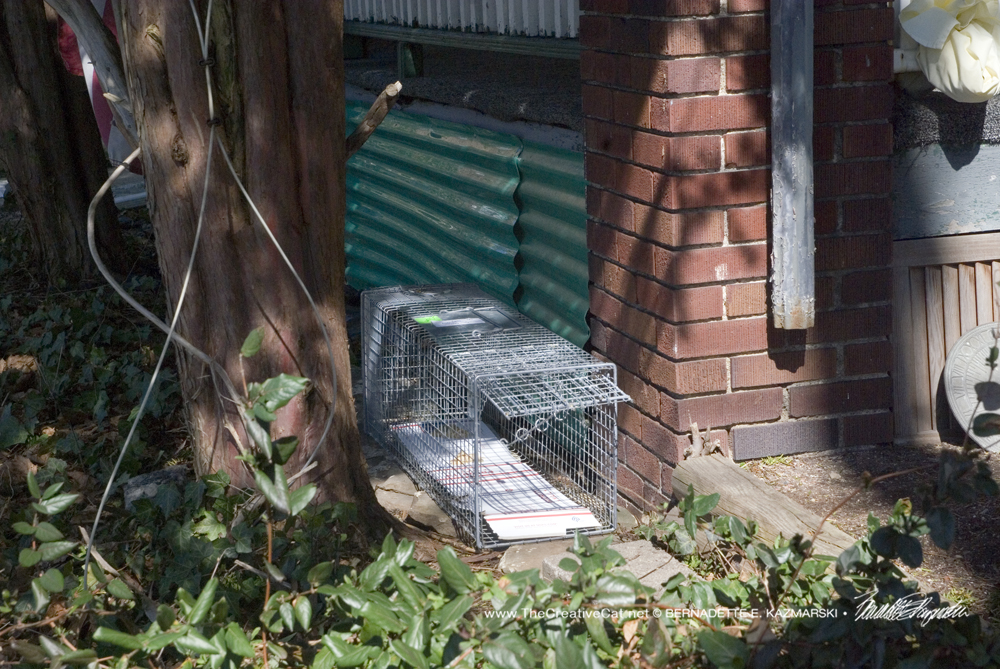
Because it’s most likely that your cat is on your property or close by, and that it may not come to you or anyone else, setting up a humane trap could help you recover your cat. The trap is baited with strong-smelling food and your cat will be hungry, especially if it’s been holed up and frightened, so the trap itself with the food may bring it out. Get the trap the first day if possible.
The trap does not hurt the cat, but when it walks inside to eat the food it steps on a plate that releases the door so that it closes behind the cat.
Your cat may feel safe to emerge from its hiding place at night when it’s quiet and fewer people are around, so even though daytime may be more convenient to set a trap and watch it, you may be more likely to catch your cat overnight.
Rather than running for your cat if you see it approach the trap, try to let your cat go into the trap. Your cat may still be in safety mode, afraid of everything that moves, and you may frighten it away.
Shelters, wildlife services, animal supply and feed stores and animal rescues often have traps to loan to you and informed people who can give you instructions and sometimes even to help you. Follow the instructions you are given about how to set the trap and bait the trap, and how to handle the trap and your cat if your cat is trapped in it.
Wildlife cameras have been used successfully to determine if the cat is in a certain area, and what time of day they appear. This can help you pinpoint the best time and place to set the trap.
If your cat begins to move from hiding
Their own nature when in their own territory determines how long they stay hidden, and what they do when they decided to emerge.
CURIOUS/CLOWN CAT who is friendly and outgoing, and when it feels safe to move will probably travel.
CARE-LESS CAT who is somewhat aloof with you and visitors, and after hiding may actually come back to your home, meow when approached by you, or may travel.
CAUTIOUS CAT who keeps a distance from strangers but may be curious, and after hiding will likely return to where they escaped from and may actually meow for their owner, but will generally stay in the area.
CATATONIC/XENOPHOBIC CAT who can be frightened in its own territory, and will usually hide, stay hidden, not respond and seem to lose its bearings altogether.
Please read the Missing Animal Response Network Lost Cat Behavior page for more specifics about the cat’s behavior and tips on how to find and catch a cat in each of these four instances, as well as other guidance.
Placing familiar items outdoors
Though one of the first pieces of advice you may hear is to place an article that has familiar scents for the cat outside where it can find it, that isn’t mentioned in most professional pet search tips. Putting a bed or blanket outside won’t hurt, but the help it might give seems negligible. Your own scent is familiar and your scent is all over things outdoors, from the doors to the car to railings and even more if you tend to spend time outdoors, and you may have tracked plenty of your cat’s scent outdoors too.
Placing the litter box outdoors
Not only is this inaccurate but it’s also dangerous to the cat.
*Why your cat might actually be in the house
A friend posted that she couldn’t find one of her fosters, one who was very friendly and generally in her face all the time. She searched the house again and began an outdoor search and found the cat in question looking out the door with another foster cat. I rescue and foster formerly feral kittens and cats, so cats hiding deep in some dark spot in my home is not unusual, and I’m accustomed to looking for them when I don’t see them for a while, then wondering at the incredibly tiny spots they can disappear into.
One of my older cats, however, did have a developing medical condition and hid in a spot I never would have found if I hadn’t persisted in looking for her inside. It’s an example of why you should thoroughly search your house unless there is an obvious exit point for your cat.
Kelly had crawled up into the underside of the housing for my chest freezer in the corner of the basement, which is blocked in by other appliances because it opens from the top; there was a cover under all the mechanisms for the freezer so there was only an open space about 8″ tall with no moving parts. The only way I knew she was under there was a little prickle in the back of my neck when I looked in that direction, and Jelly Bean sat by the corner of the freezer and kept looking intently at the bottom of it. I strung a mirror on a piece of clothesline and lowered it behind the freezer to the floor, then managed lie on top of the freezer and angle a flashlight onto the mirror which illuminated underneath the freezer, and there was Kelly, like, “What? This is a nice place. I like it.” And came walking out as if I hadn’t just totally tossed the basement and a good bit of the rest of the house looking for her. As it turned out, she was having mini-seizures that weren’t detectable until a few months later.
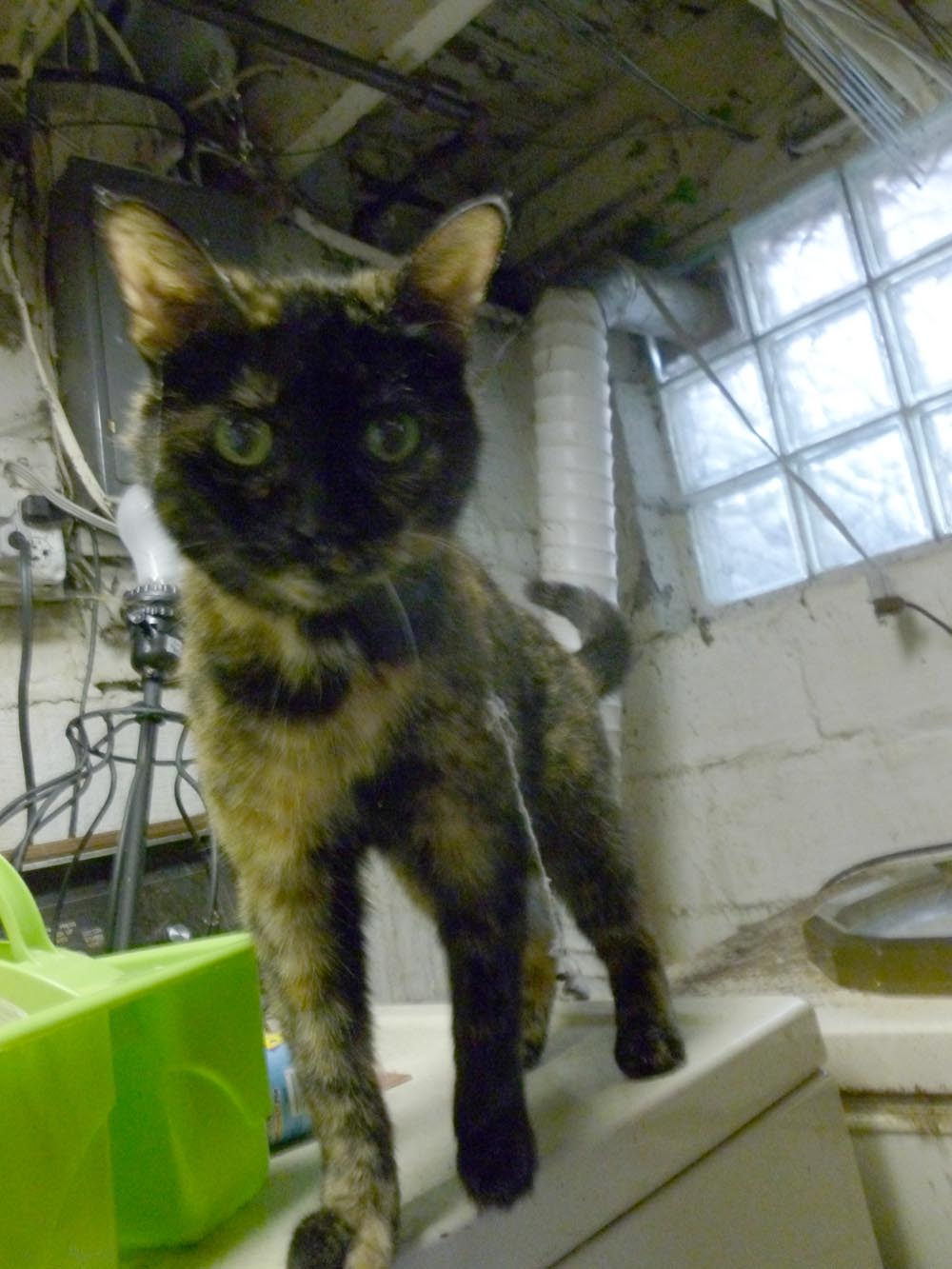
**Buster was the subject of “Buster Lookin’ at His Toes” and “Kitty and Buster”. Poor guy was really traumatized by his adventure outdoors, but was fine after some extra hydration and quiet time indoors.
Resources:
The Missing Pet Partnership website https://www.missinganimalresponse.com/kat-albrecht/
“The Science of Finding Lost Pets”, Kat Albrecht, The IAABC Journal https://fall2016.iaabcjournal.org/science-finding-lost-pets/
“How to Find and Recover a Lost Cat”, Kat Albrecht, The International Cat Association (TICA) University (PDF article) http://ticau.com/pages/psychology/recover.pdf
“Understanding Lost Cat Behavior”, Kat Albrecht, Powerpoint presentation at Animal Care Expo 2016 https://www.animalsheltering.org/sites/default/files/Understanding%20Lost%20Cat%20Behavior-Albrecht-Kat_1.pdf
Cats in the Bag http://www.catsinthebag.org/
Petfinder Must-do Tips for a Lost Cat https://www.petfinder.com/cats/lost-and-found-cats/tips-for-finding-lost-cats/
The Center for Lost Pets http://www.thecenterforlostpets.com/advice.aspx#anchor_lostcat
Discussion about putting the litter box outside:
https://www.missinganimalresponse.com/lost-pet-behaviors/kitty-litter-myth/
https://www.facebook.com/CommunityCatCoalitionWa/posts/911317935676201:0?hc_location=ufi
Read more articles in the category Health and Welfare
I have comments turned off on this post because it was getting a lot of spam.
Gifts featuring cats you know! Visit Portraits of Animals
Feline Gifts from Portraits of Animals!
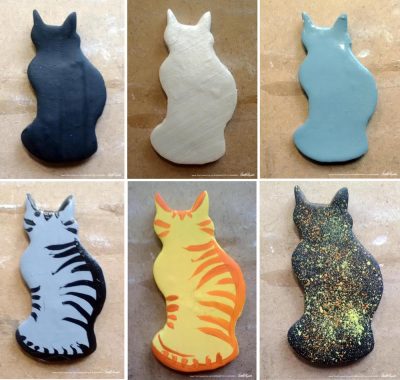
I worked out the manufacture of my own “die” or basically a cookie cutter to use for creating consistent shapes of one of my sketches. Each magnet is hand-painted. Read more.

Copyright
All images and text used on this site are copyrighted to Bernadette E. Kazmarski unless otherwise noted and may not be used without my written permission, although links to your site are more than welcome and are shared. Please ask if you are interested in using and image or story in a print or internet publication. If you are interested in purchasing a print of an image or a product including it, check my animal and nature website Portraits of Animals to see if I have it available already. If you don’t find it there, visit Ordering Custom Artwork for more information on a custom greeting card, print or other item.
Subscribe to my e-newsletter
Subscribe to The Creative Cat Preview E-newsletter.
© 2022 | www.TheCreativeCat.net | Published by Bernadette E. Kazmarski
Weekly schedule of features:
Sunday: Essays, Pet Loss, Poetry, The Artist’s Life
Monday: Adoptable Cats, TNR & Shelters
Tuesday: Rescue Stories
Wednesday: Commissioned Portrait or Featured Artwork
Thursday: New Merchandise
Friday: Book Review, Health and Welfare, Advocacy
Saturday: Your Backyard Wildlife Habitat, Living Green With Pets, Creating With Cats
And sometimes, I just throw my hands in the air and have fun!



Pingback: Independence Day Hazards for Pets ~ The Creative Cat
Pingback: Independence Day for Our Animal Companions, Not So Fun ~ The Creative Cat
Pingback: 4th of July Festivities, Not So Much Fun for Our Pets and Wildlife ~ The Creative Cat
Great post. Thanks a lot
I hope it helps find a kitty.
If you found or lost a pet report it on this website. They can help you find your missing pet
https://www.pawmaw.com
https://www.lostmykitty.com
Pingback: 4th of July is Not So Much Fun for Them ~ The Creative Cat
Pingback: Never Give Up: Former Feral Amy, Lost, Found, Recovered and Home After Eight Months ~ The Creative Cat
Thanks for the post. I like back cat
Thank you for visiting!
Pingback: Mimi Gives Me A Lesson About Screens ~ The Creative Cat
Pingback: Independence Day for Our Animal Companions, Not So Fun ~ The Creative Cat
Pingback: Windows, Screens and Cats: Just a Little Adventure ~ The Creative Cat
Pingback: Windows, Screens and Cats ~ The Creative Cat
B; THANX for this post; have saved it, and hope to cod I never have to use it, but will definitely share it ~~~~~ L ♥♥♥
We hopes you all stays put in your little Trout Towne, Tabbies!
Very timely, since the beginning of summer marks more in-and-out traffic. I pass on lost cat notices through Facebook, and have noted many cats have gone missing within the past few weeks, just in my area alone. Your advice is well-described and useful.
Mollie, that’s a big compliment coming from you–thanks! In our rescue and generally I’ve seen just as many lost cat posts as found kitten posts at this point. Everyone gets different information for what’s next and what’s important. I really hope to clarify that according to feline behavior, not necessarily “common sense”.
Bernadette – this just happened to us a couple weeks ago, for the first time in more than 40 years!! Our 20 pound, big-but-timid tabby disappeared. We didn’t even know when he left. I was going out on the deck – where our three ferals have their shelter and food and beds – and whistling for Pipper every half hour or so. On what we figured was the third day he was gone, I turned around to go back into the house, and standing behind me was a terrified brown tabby, with his tail sticking up absolutely rigid and shaking! He was too heavy for me to pick up and manuever with my walker, so I ended up putting him down near the sliding door and just shoved him inside. I’ve always read people’s stories about their cats escaping, and now I understand how easily it can happen!
This information is VERY helpful! Thank you.
I have no idea where your comment was for the past week! Wow, I can’t imagine how frightening that was when you are using a walker and can’t really even go and look. But like they said, he came back to the spot where he likely left from. I’m glad the big boy came back!
A genius resource, Bernadette, which I hope never to need. Thank you from the bottom of my heart.
Meg, I’ve never lost a cat for more than a day and I’m glad to share this so it works out that way for everyone.